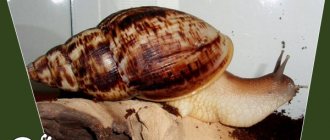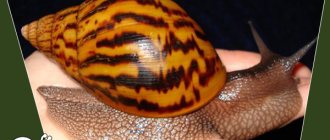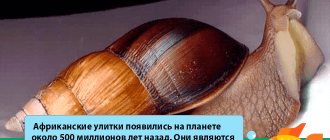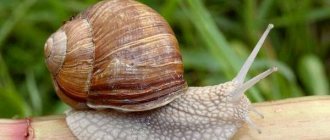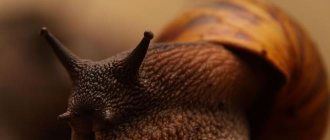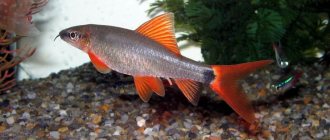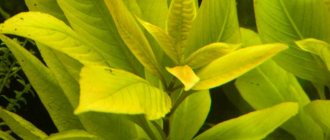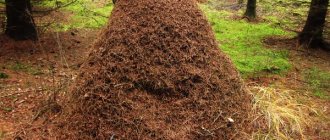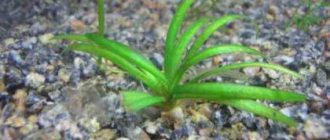The giant Achatina Fulica is the largest species of land mollusk in the family Achatinidae, commonly known as the African snail or the giant African land snail.
Native to tropical countries with a hot climate, where it causes serious damage to crops and native plants, being an agricultural pest, especially for sugar cane.
It belongs to an “aggressively” invasive species (one of the hundred most active invasive species), and is a carrier of a dangerous human infection. In European countries it is kept at home as an unpretentious pet. It is actively used in cooking and cosmetology. Read more about home snail therapy in our article.
Where does Achatina Fulika live?
Today, the spread of the snail's range has been stopped only thanks to strict quarantine measures. America was the first to introduce quarantine. Achatina's giant homeland is East Africa, but this mollusk has reached other parts of the world through trade as a food resource and accidental hatch.
This species was found in Xiamen (China) in 1930. Then Achatina went to Pratas (Taiwan Island), then throughout India and the Pacific region, from there to the Indian Ocean islands and the West Indies.
In the United States - in Hawaii and Florida, the most severe destruction of the Achatina snail is underway.
In Europe, due to climatic conditions, the survival of Achatina in nature is impossible; they are kept as pets.
Control measures
To control the number of Achatina, an extract of the fruits of the Peruvian tevetia (Thevetia peruviana) is used, and to scare away (for example, a garden plot) - a fence made from cuttings of smooth annona (Annona glabra). Chemicals used include metaldehyde (must be used carefully so as not to destroy other types of snails), calcium arsenate, sodium chloride, copper sulfate solution. Insecticides (malathion, trichlorfon and mexacarbate) are added to wet wheat flour and placed as baits around the area. The most effective and safe way to control the number of Achatina is manual collection (at night, especially after rain); clearing the site of potential hiding places for snails; creation of “bare” strips of land (1.5 m wide) and arrangement of protective ditches dug around the site. Collected snails are sprinkled with salt or left in the sun, which leads to their death.
Subspecies Achatina fulica
- Achatina Fulica hamillei Petit
- Achatina Fulica rodatzi Dunker
- Achatina Fulica sinistrosa Grateloup
- Achatina Fulica umbilicata Neville
Achatina Fulica Hamillei
Several hundred Fulica Hamillei have recently been observed in Bhutan and have begun attacking farmland and flower beds. It is believed that local stray dogs died because they were eaten.
See more similar articles:
How to choose an aquarium for keeping the Achatina snail:...
Terrarium for the Achatina snail - rules and examples...
Back Forward 1 of 16
Achatina Fulica rodatzi (albino)
An adult Fulica rodatzi measures over 20 cm (7.9 in) long and 7 cm (2.8 in) tall. The shell of Achatina is cone-shaped, approximately twice as long as it is wide. The direction of the curls of the giant Achatina shell is twisted either clockwise (more common) or counterclockwise.
Achatina Fulica sinistrosa
The color of the shell varies greatly and depends on the genetic data of the mollusk, but as a rule, brown color predominates. For Achatina fulica, a temperature of 23-27 degrees will be optimal; the snail can easily tolerate a temperature drop of up to 2 degrees. Achatina Fulica sinistrosa is native to East Africa, Kenya and Tanzania.
Numerous Achatina colonies can be born from a single pregnant snail. With confident steps it is colonizing some regions with a temperate climate. Currently, Achatina Fulica sinistrosa prefers regions in the humid tropics, also the Pacific Islands, South and East Asia, and the Caribbean.
Achatina Fulica umbilicata
Achatina fulica today can be found in agricultural areas, in coastal areas of natural forests, in leopards, in bushes, in cities, and near wetlands. For Achatina Fulica umbilicata, the optimal temperature for existence is 24-28 degrees, but it survives even when the temperature drops to 4 degrees.
Achatina fuсlica var, White Jades
White jade is an albino variety of Achatina fulica. She has a massive white body and a light-colored shell. Feels great in coconut bedding with a scattering of moss.
Demanding on soil moisture. If the humidity in the terrarium is too low, the snail goes into hibernation. Feels comfortable even at room temperature.
Spreading
The homeland of the giant Achatina is the coastal part of East Africa (Kenya, Tanzania, Somalia). Currently, Achatina has spread throughout tropical and subtropical zones as an invasive species: Africa (the islands of Madagascar and Mauritius); East Asia (India, Sri Lanka, Malaysia, Myanmar, South China, Taiwan, Japan, Philippines, Thailand, Indonesia); Pacific region (Bougainville, New Caledonia, Fatana, Guam, Northern Mariana and Marshall Islands, Palau, Papua New Guinea, French Polynesia, Samoa and Tahiti, Timor, Vanuatu); Caribbean countries; South America (Brazil, Argentina, Bolivia, Peru, Ecuador); USA (Hawaii, California, Louisiana), Turkey, Greece, o. Majorca.
Article on the topic Names for snails (boys)
What and how to keep Achatina Fulik
At home, Achatina is kept in a terrarium, aquarium or plastic container, which must be at least 5 times the adult length of the snail. Give preference to a wide container rather than a tall one. Take care of proper ventilation to prevent mold and midges from appearing later. Read how to deal with midges here . At the bottom of the terrarium, place high-quality soil or coconut substrate, a bedding of dry leaves, moss, etc. The soil should be about 1/3 of the aquarium. They bury themselves in it during the day and sleep.
For Achatina, it is important to maintain soil moisture, but do not allow it to become waterlogged. The optimal humidity level is 65–75%. You can maintain humidity using a shallow container of water.
Achatina fulica feels great at a temperature of 22-26 degrees; an incandescent lamp or a thermal cord will help you maintain this temperature.
Nutrition
Achatina fulica is polyphagous, i.e. omnivores (can eat paper, cardboard, bones and even concrete), they find food using their sense of smell. They feed using a “tongue” (radula), seated with small horny teeth. The snail's diet includes various plant parts, fruits, rotting vegetation, carrion, excrement, fungi, algae, lichens and mushrooms.
Snails eat more than 500 different plant species (e.g. alstroemeria, amaranth, wildflower, andropogon, annona, anthurium, betel palm, breadfruit, jackfruit, averroa, bougainvillea, bryophyllum, Indian canna, centrosome, cereus, chrysanthemums, coffee, jute , cordyline, cosmos, dahlia, dragon tree, oil palm, eryngium, eucalyptus, herbaceous cotton, heliconia, sunflower, hevea, hibiscus, impatiens impatiens, sweet potato, Indian jasmine, Kalanchoe pinnate, lagenaria, luffa, cassava, mimosa, momordica, morinda , mulberry, tobacco, oncidium, prickly pear, oxalis, jicama, passionflower, phalaenopsis, physalis, betel, purslane, pueraria, rose, sage, sansevieria, sesame, sorghum, tabernemontana, marigold, teak, tephrosia, thespesia, vanda, cowpea) , including cultivated (legumes, pumpkin, nightshade, lettuce, radish, spinach, carrots, onions, citrus bark and fruits, papaya, peanuts, cabbage, ginger, bananas, vanilla, grapes, rubber trees and cocoa). Young snails, up to about 4 months of age, feed almost exclusively on young shoots and succulent leaves.
What and how to feed Achatina Fulika
The giant African snail is a macrophytophagous herbivore; She eats a wide range of plant foods, loves fruits and vegetables, sometimes eats sand, very small stones, bones from carcasses and even plaster as a source of calcium.
To build a strong shell, Achatina snails need calcium carbonate. On rare occasions, they nibble on each other's shells. At home, Achatina is fed with grain mixtures, chicken food and fish food. Don't forget to pamper your pets with treats that you can easily prepare yourself.
For good and rapid growth of the snail, the daily diet of Achatina fulica should contain about 18.28% crude protein.
Achatina Fulica prefers to feast on soft plants or slightly decaying foods. But you don’t need to worry about its health; a snail will never poison itself. Young snails prefer to eat young plants, while older snails prefer to eat dead, rotting remains.
As the snail ages, the amount of food consumed increases. At home, it is recommended to feed cauliflower, pumpkin, mushrooms, champignons, zucchini, dandelion leaves and other vegetables except citrus fruits.
Once a month you can give boiled porridge without salt. Be sure to include calcium and protein supplements in your Achatina menu. See their recipes here . Rarely and in small quantities, you can give a few pieces of boiled chicken without salt.
For the Achatina snail, it is fatal to consume table salt, sugar, citrus fruits, spicy and sour foods.
For a beautiful shell, the mollusk’s diet should be supplemented with eggshells ground into dust, river shell rock, feed chalk and bone meal. Also, do not forget about sepia, which is sold in pet stores and should always be in the terrarium.
The more different sources of calcium a snail has, the easier it is to grow a large, beautiful and durable shell. Don't forget about protein sources: gammarus, daphnia or grain mixture.
Useful tips
The snail can be considered a rather specific pet, however, it also has its fans. Owners note their ease of care and ability to reproduce quickly. As for Europe and Russia, the mollusk cannot be found here in the natural environment. Most often it is planted for decorative purposes. If you want to decorate your aquarium, it’s not difficult to do. The main thing is to think about the safety of the shellfish. You can use natural elements, for example, moss or beautiful driftwood. However, we must not forget about disinfection.
As for care, it is advisable for adults to provide a bowl of clean water. In order for the humidity to remain at the required level, the lid must always be tightly closed. Firstly, care is not burdensome for the owner. Secondly, she does not require walks. It is also impossible not to note the minimal maintenance costs.
Achatina is a very quiet pet, it is especially active in the dark, however, provided there is sufficient humidity, it can also appear during the daytime. If the temperature drops below +9 degrees, the mollusk goes into hibernation.
When creating a microclimate, we must not forget that Achatina is a tropical mollusk. To ensure comfort, it needs warmth and moisture. It is best if the air temperature remains at 25-28 degrees. If the room is cooler, the snail will become less active. Don't forget to regularly spray your pet's home with water. The best houses for clams are containers made of glass or plastic. Ventilation must be provided to ensure sufficient access to fresh air. It is also necessary to ensure that the top lid of the container is heavy and does not move, otherwise there is a risk that Achatina will run away.
How much water Achatina has enough can be understood by its behavior. Hidden in the shell, the mollusk signals dryness in the aquarium, and sitting on the walls for a long time, on the contrary, signals excessive humidity. If the owner needs to leave for some time, the snail can be provoked into hibernation. This creates dryness in the container. To wake up a clam, it should be placed under a stream of warm water. You should focus on the size of the snail; specimens that are too small can squeeze into the holes, because they move well along the walls and lid. Experts also recommend avoiding bark and sawdust. Your pet's delicate body can be easily scratched.
Snails feed on plant foods. Soft plants are great. At a young age, Achatina will prefer living plants; when they are more mature, rotting remains will do. Most often, at home, shellfish are fed with cabbage, cucumbers, zucchini and other not too hard vegetables.
A pet will not be able to actively grow and develop without protein and calcium. Therefore, it would be a good idea to occasionally pamper him with pieces of boiled chicken. Porridge made from a cereal mixture will also work. Pickles and smoked products are prohibited. At a tender age, you should not give snails a lot of food, as they will tend to burrow into it, which can lead to suffocation.
Achatina is a land mollusk. Its length can reach 30 centimeters, which is an impressive value. Natural habitat is the tropics. As for France, Achatina is very popular there. They reproduce and grow very quickly. This allows the active use of such snails in local cuisine. As for living in the natural environment, the snail is quite harmful to agricultural crops. Sugar cane is considered her favorite delicacy. In addition, Achatina suffers from a lack of calcium, so it scrapes lime off the walls of buildings with its shell. This causes them significant harm.
What soil to choose for Achatina snails, see below.
Aquarist with many years of experience
The Achatin snail is the largest land mollusk. Since the original habitat of snails is the tropics, special conditions are required for their maintenance. The life of mollusks, not to mention the ability to reproduce, can depend on a properly selected terrarium and soil.
Therefore, before buying a new pet, it is important to study the characteristics of the habitat and the rules for selecting soil for Achatina snails
Special conditions are required for keeping Achatina snails
What to feed the little Achatina fulika
It is strictly forbidden to give salted, smoked, or alcoholic foods - it will be fatal. Also, do not forget about ground mixtures of cereals, seeds and herbs, and porridges. Sometimes they feed boiled porridge “from three grains” without salt, a mixture of ground cereals, herbs and seeds. Read more in our article .
At home, small Achatina are given lettuce leaves, grated pumpkin, cucumber and carrots. Sweet fruits, pureed daphnia, gammarus and calcium: eggshells, food chalk, sepia, etc.
Newborn Achatina Fulica should be fed from 2-3 days with soft food and very little, so that the babies do not bury themselves in the food and suffocate.
Reproduction of the giant Achatina
Achatina Fulica – hermaphrodite; Each snail has testes and ovaries, which means it produces sperm and eggs. Self-fertilization occurs only in small populations. Usually both snails in a pair simultaneously transfer gametes to each other (bilateral).
Achatina begins to reproduce when it grows to a certain size and age. Mollusks of the same size mate more often.
Achatina of different sizes mate unilaterally with a larger snail, which serves as the female. A mating pair of Fuliks is immediately visible by their intriguing mating behavior: prolonged caresses of each other's head and front parts of the body.
Courtship can last up to half an hour, the actual transfer of gametes lasts for two hours. The resulting sperm can remain in the mollusk’s body for up to two years. See more information about snail reproduction here .
The number of eggs in a clutch is more than 300. Achatina fulica can lay five to six clutches per year with egg viability of about 90%. Achatina Fulica grows actively until about six months, after which growth slows down, but does not stop.
The average lifespan is usually five or six years in captivity, but Achatina Fulica can sometimes live up to ten years.
Structure
The body is divided into 4 main parts - the visceral sac, mantle, head and leg. The lungs are located between the head and mantle. There are no gills. Breathing is cutaneous, supplementing breathing through the lungs. The head is well developed and attached to the rest of the body with a kind of “neck”. The skin is pimply and wrinkled.
The shell is massive, thick-walled, left-sided (occasionally right-sided are also found) consisting of 7-9 whorls. Shell shapes can vary even within the same colony. Usually the shell is conically pointed and distinctly narrowed, but barely elongated at the apex. The curls are rounded with moderately pronounced seams between the curls. The shell opening is relatively short, ovoid-lunate in shape. The lip is sharp, convex, thin, evenly curved into a regular semi-ellipse. The surface of the shell is relatively smooth, with weak axial growth lines. The columella is usually concave.
The horns are small, two pairs. At the ends of the upper pair are the eyes, on the lower pair are the organs of touch and smell. The radula (“grater”) contains about 142 rows of teeth, 129 teeth in each row). On either side of the radula there are two salivary glands that secrete mucus. The esophagus is tubular, long with many folds.
Behavior of Achatina Fulik
They are more active at night. They spend the daytime in secluded places, buried in the ground, and become active only in the evening.
American scientists have established that Achatina Fulica has long-term memory: it remembers everything that happened within half an hour, remembers the location of the feeder with food and can return to it.
Young Achatina fulicas are mobile and capable of long-distance migrations. In nature, they do not return to the same place.
Old snails, on the contrary, have a permanent resting place, from where they crawl out in search of food. They try not to move away from the house more than 4 - 6 meters. When moving the fuliks from their shelter 20 meters, they easily return back.
African Achatina, if kept in poor conditions, can hibernate for up to 6 months. Low temperature and humidity in the terrarium, changing the diet, replacing the soil with a different type of substrate, etc.
The snail seals itself in the shell by secreting a secretion of calcareous compounds, which dries out when exposed to air. This is an impermeable material.
While hibernating, the mollusk uses up the water reserves of its body. And with the reserves, the vital forces of Achatina fulik also go away. If your Achatina has gone into hibernation, there is no need to panic, spray it with warm water or increase the humidity, it will quickly wake up.
Skin care products
A relatively inexpensive alternative to massage is cosmetics containing snail extract. But it contains many additional components, and accordingly the concentration of active substances is different than in the mucus itself.
Many cosmetics manufacturers, especially Korean ones, produce entire series: creams, masks, primers, and makeup remover emulsions based on snail mucus. The names of the products contain the terms filtrate or mucin. These words mean the same thing as extract and mucilage.
Cosmetic products with snail secretion nourish and protect, smooth out wrinkles, create a lifting effect, and mattify the skin.
What diseases does Achatina Fulika suffer from?
Parasites of Achatina fulica:
- Aelurostrongylus abstrusus, Angiostrongylus cantonensis – causes eosinophilic meningoencephalitis
- Angiostrongylus costaricensis – causes angiostrongyliasis
- Schistosoma Mansoni – causes schistosomiasis, found in feces; Trichuris SPP and Hymenolepis SPP – found in feces
- Strongyloides SPP – found in feces and mucous secretions
In the wild, Achatina Fulica often harbors the parasitic nematode Angiostrongylus cantonensis, which causes very serious meningitis in humans. You can become infected with meningitis by eating poorly cooked or raw snail meat. Even well-cooked wild snails can infect humans with nematodes and cause a life-threatening infection.
Achatina giant is an invasive species. It is a pest of agriculture and homestead farming. Infects humans, animals and plants with pathogenic microorganisms.
To prevent its introduction and further spread, strict quarantine has been introduced in many countries.
Achatina Fulika in cooking
Snails have been used as food since ancient times. The Egyptians and ancient Greeks highly valued snail meat for its dietary value. Read recipes from Achatina here. Therefore, during World War II, Achatina Fulica was used as a food reserve for American soldiers. But not only the American military ate the giant snail during the war; the soldiers of the Japanese army also fell in love with it.
In Africa and some cities in Brazil, Achatina is used for religious purposes, as a rich offering to the deity Oxala. In Nigeria, Achatina fulica is revered not only as an offering to the gods, but also as an easily accessible source of protein. All Africans eat the giant snail.
